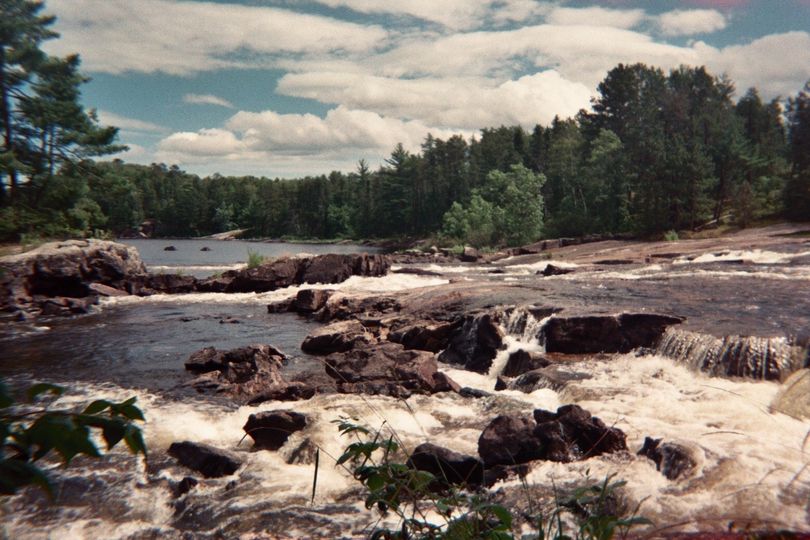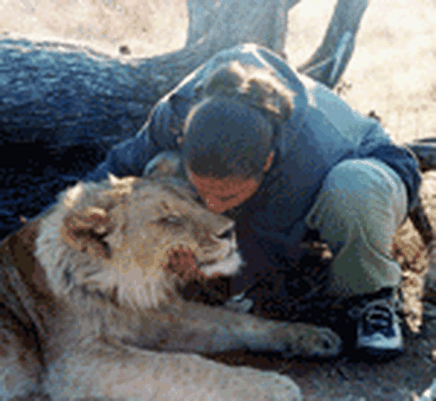The Boundary Waters: Report, Continued

The storm never came, and my friend and I took the canoe out for a paddle. We were on a mission to get fresh water, which we were told could be found closer to the middle of the lake. Hmm. Maybe it was potable, but the brackish color demanded some attention. Back at the campsite, we dropped in our water tablets, hoping they would clear the water of germs and the brown hue. Instead, the water turned an interesting shade of orange. Thinking we'd be hard up for clean drinking water all trip, we dropped the neutralizing tablets in, and to our immense pleasure watched the water turn a beautiful shade of, well, water.
Liquid concerns out of the way, we sat on the logs around our campfire and looked out over the lake. A wonderful sense of calm invaded me. I could hear the call of the loon, we saw ducks swimming just in front of us, and birds chirped and cooed to each other. In the stillness, we could hear other paddlers passing by, but they were few and far between. I felt a peace I can rarely find in the city.
And then I felt the mozzies. The bloodsuckers up there are intense. We had encountered them on the portage, but I was so busy trying to put one foot in front of the other that I didn't take much notice of them. Sitting quietly by the fire, they suddenly had my attention. Not only are the mosquitoes huge, but they are the only mozzies I have ever met that I can feel as they poke through my skin. That's how big their proboscis is. And it was to their detriment- as I could feel each one biting me, I was able to kill them as they sucked me dry. Within just a few minutes, I was covered in streaks of my own blood. Thinking quickly, my friend grabbed a bottle of Deep Woods Off and soon we were surrounded in a thick cloud of the repellant. It helped, but it didn't stop the bugs entirely. I think I heard one mosquito laugh as he buzzed through the mist.
The next morning, scratching to our hearts' content, we broke camp and set out for the northern reaches. Trudging over the next portage wasn't as difficult as the day before. Perhaps we were getting stronger, but I think carrying the canoe by hand rather than head made a huge difference.
Settling into the canoe on Pipestone Lake, we made sure our life jackets and ponchos were in easy reach. The clouds had looked threatening all morning, and they didn't seem as if they would be leaving us alone anytime soon. Getting back into the groove of relaxed paddling, I spent some time taking in the sights. It was wooded wilderness everywhere we looked. The shoreline was never far away and the water was dotted with islands. The Forest Service did a masterful job of minimizing human impact on the area by limiting the number of people as well as campsites. As the campsites are sparse, there is plenty of room between sites. Most of the time, they are set back from the water and you can find them only as you come right up on them. From afar, the Boundary Waters look uninhabited, and we were enjoying the calm, unbroken shorelines that stretched in front of us. In the distance, we would occasionally see other boats, but the empty feeling remained. We certainly weren't in a standard state park with campers crowding for space.
We were about an hour out from the last portage when the rain started. It began as a soft drizzle, nothing to be concerned about. Staying dry wasn't something we had expected, so we continued our casual paddle, aiming for one of the large islands further up the lake. That's when the mist set in. Once I could no longer see the island, which had been clear as day only minutes previously, I started paying closer attention to the weather. The drizzle was quickly turning into a downpour. Soon, huge, fat drops were pelting into us. We donned our ponchos to keep the worst of it off, and then seriously talked about finding a spot to kip for the night. Five minutes later, we weren't talking at all- our concentration was entirely focused on trying to find the shore that had suddenly vanished. Moving closer in, we could see the shoreline, and then a sandy beach. Pulling into the beach, I checked our map to find that we had, indeed, found a campsite. Hauling everything along a track to the fire pit, we set up in the rain and piled into the tent. The torrential rain quickly abated, and we were left with the decision of packing back up and moving further north, or staying put. We decided to stay where we were and use this site as our base camp for the next two days. Paddling an empty canoe would be easier than one loaded down with gear, and it would shorten our exit paddle on leaving day.
After setting up a tarp, making lunch and collecting firewood (which we hoped would dry by that evening), we debated taking the canoe out for a paddle. By then the sun had come out and the day was dazzling. Instead, we hit the beach and worked on 'meditating' (it sounds so much less cancerous than 'tanning'). We spent a few lovely hours soaking up the silence, broken only by the call of a loon or an occasional paddle scraping the side of a canoe further out on the lake.
Making good use of our propane burner (the wood hadn't dried), we made hot chocolate, followed by dinner. The dinners the shop had sent with us were freeze dried packages that just required a little hot water. We had the choice of sweet and sour chicken or chicken and rice. We also had two precooked slabs of ham. We went with the ham. Heating the slabs up on the camp stove, we slathered on as much mustard as we could dig out of the bear barrel and made ham sandwiches. Not bad, considering.
The next morning was bacon and eggs. I fried up all the bacon we had to make sandwiches for lunch, threw in some gorp and Power Bars, and we packed it all into a small rucksack for our big push north. We were going to be gone all day, making the trek up to the Canadian border. We had heard tell of some waterfalls on the border and had made that our mission for the day. Based on intel from the shop and checking our position on the map, we were looking at three hours each way, plus breaks and time at the falls. After punishing us the day before, the weather cleared up and we had a hot sunny day full of gorgeous blue sky. And as if to apologize for the hammering we'd had the day before, the wind was at our backs, giving us a smooth, easy ride. We made the falls in just over two hours.
Checking the map for the Basswood Falls, we almost missed the first cataract leading to them and had to back paddle to the landing area. Following the walking trail along the water's edge gave us an ample view of the miniature falls, and made the short walk one of the most scenic I've encountered. Finally rounding the bend, hearing the rush of the water, I was disappointed to see that Basswood Falls were all of ten feet high. I was expecting proper waterfalls. We got an overgrown cataract. But it was beautiful nonetheless.
(Read the conclusion of The Boundary Waters: Report in next week's blog)
